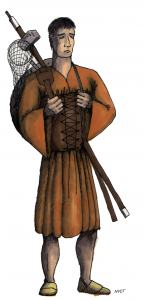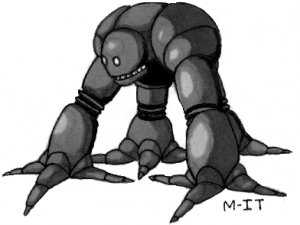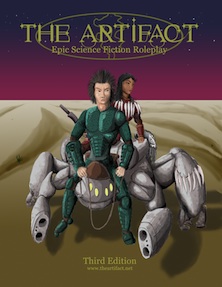For the last two days I’ve toured the largest cave system in the world, Mammoth Caves. For an explanation on how to use these stats, check out the original Survival Games post.
Cave
A cave can act as shelter for PCs or any number of creatures. Few are likely to travel deep into the cave past the line where light from the outside starts to fail but may be chased further into the cave. Elephants have been seen entering a cave to get at minerals in the rock and dirt. Humans have a deep fascination with caves. In Mammoth Caves, Native Americans traveled deep into the cave using only bundles of reeds for torches. Some areas of the cave floor are covered in these burnt reeds. In some areas that modern cavers are only just exploring with modern equipment, they will find a footprint or a torch of someone who had been there 2-4000 years ago. Why did they travel so deep? We don’t really know.
Players may be tasked with finding ancient artifacts left behind or the cave may surface in a different place, providing a route to travel through.
Surmount Method: Squeezing through tight passages, climbing over rubble strewn floors, up and down rock faces, swimming through subterranean rivers.
Surmounting Attribute: Constitution
| Full | 1/2 | 1/4 | 1/8 |
| 1 | 2 | 3 | 4 |
Surmounting Attribute: Strength (for Climbing)
| Full | 1/2 | 1/4 | 1/8 |
| 1 | 1 | 1 | 2 |
SP 1 per 10 meters
Hazards
Exertion
For every failed Constitution or Strength roll the characters face an exertion hazard. They get a -2 CDF to Str and a -2 CDF to Con (or 5-6% of the attribute). CDF penalties accumulate until the characters can recover for a period of time. While recovering, the player rolls for the character’s Con. A Full result means 1 point of Str and Con are recovered. A 1/2 result means that 2 points are recovered. A 1/4 result means 3 points and a 1/8 result means 4 points recovered. If the CDF penalties exceed their Con the character must be rescued off the rock face or fall if they fail another Str roll.
Random Hazard
For every survival round the GM should roll once on the following table.
Roll 1D100
| 1-25 | Tight Passage |
| 26-40 | Loose Rock |
| 41-60 | Dome Pit |
| 61-70 | Vertical Climb |
| 71-80 | Confusion |
| 81-90 | Tunnel Splits |
| 91-95 | Tunnel Ends |
| 96-100 | Underground River |
Tight Passage
Characters must crawl through very tight tunnels to move deeper into the cave. Large packs and equipment must be either disassembled and dragged through or left behind. Passages are so tight that characters may need to exhale to fit through. Characters must make a Psyche roll (willpower) to make it through.
Loose Rock
Loose rocks of various sizes cover the passage floor. Traveling over them is treacherous. While slips and falls are minor hazards the injuries can build up over time. Characters must make an Agility roll. If failed they get a -2 CDF to Con (or 5-6% of the attribute).
Dome Pit
A vertical shaft with a dome at the top intersects the passage. The shaft is 1D6 meters wide and may be too wide to jump across. There is also a 25% possibility that the passage is too short to allow a person to jump. Characters will have to devise a method of crossing.
Vertical Climb
A vertical shaft continues the passage either up or down for 1D10x2 meters. Use the Rock Wall obstacle stats for this part of the passage.
Confusion
The characters must make a Subterranean Navigation skill roll or the party is thrown off course for a period of time. Add 2d6 to the remaining SP of the obstacle.
Tunnel Splits
The Tunnel splits into two main passages. If the players have a specific goal to reach, they must pick one of the tunnels. There may not be any way of knowing which tunnel is the correct one unless someone has already mapped the tunnels. If someone has mapped them, make a Subterranean Navigation skill roll to pick the right one.
Tunnel Ends
The tunnel abruptly ends, possibly by getting so narrow that a human cannot pass through. If there is a goal the players have to reach that has not been accomplished, the GM may decide that there was a branch in the path some way back, possibly obscured by a rock or a rock formation.
Underground River
Most caves are formed by rivers, in this cave’s case the river has carved another passage that is still full or mostly full of water. To keep going the characters will have to swim through the river. There is a 50% chance that the characters will have to hold their breath for 2D10 meters along the river’s path before they emerge again in a dry passage. Players will not know how far they have to go underwater. Con roll is required for every turn underwater to stay focused. If the Con roll is failed they must seek air.
Defenses and Weaknesses
10% Chance Defenses: Foul Air
Caves may not always have breathable air. Methane, Co2 or other gasses may make air unbreathable in some or all of the cave.




 The Free RPG Blog
The Free RPG Blog